中西文化比较与翻译赏析共33页文档
- 格式:ppt
- 大小:825.50 KB
- 文档页数:33


中西方文化差异(汉译英)(翻译要求:英文单词字数达到4000字)中西方文化差异摘要:随着经济全球化的不断发展,中西方国家之间的交流与合作越来越密切。
由于中西文化差异一直是制约中西方国家的人们进行交流的重要因素,对中西文化差异缺乏必要的了解,在交际过程中就会遇到一些交际障碍和误解。
分析和比较中西方在饮食、礼仪、语言方面的文化差异,了解和熟悉中西方文化内涵和特点,才能增强对他国文化的适应力,促进双方文化的融合汇通,从而实现跨文化交际。
关键词中西文化差异比较促进交流前言文化是人类社会特有的现象,是人们社会实践的产物。
文化又是一个非常广泛的概念,它包括一个国家或民族的历史、地理、风土人情、传统习俗、生活方式、文学艺术、行为规范、思维特点和价值观念等。
中西方文化都有着悠久的民族传统,在漫长的社会发展和历史沉淀中也都创造了千秋各异的辉煌。
饮食、礼仪和语言是中西方国家的人们在日常交际中首先接触到的东西,它们犹如一面镜子,反映着一个民族的文化传统,揭示民族文化的内容。
不同的民族文化造就了中西方在饮食、礼仪和语言文化等方面的差异。
在当今跨国域、跨民族的经济、文化和社会交往与日俱增的时代,如何发扬中国民族传统文化,与西方文化进行合理有效的融合,已成为人们思考和探讨的话题。
因此,深入了解中西方文化差异的表现及找出其深层次的原因,避免文化冲突显得非常必要。
一、饮食文化的差异不同的民族和国家都有各自的饮食文化特色,具有浓郁的民族性和多样性的特点。
中西方烹调方式和饮食习惯受气候环境、生活习俗等因素的影响也存在不同程度的差异。
下面我们就从营养口味、烹调方式、餐饮习惯等方面来了解中西饮食文化的差异。
(一)营养口味的差异。
西方饮食是一种理性观念,烹调讲究营养而忽视味道。
他们生吃西红柿、青瓜、生菜,甚至是洋白菜、西兰花等蔬菜,认为蔬菜只有生吃才能保证它原有的营养和原有的味道,而生炒煎煮会破坏蔬菜的维生素。
他们食用半生不熟的牛排、猪排和炸鸡,以冷饮佐餐,翻来覆去总是那么几个花样,一道菜在不同的地区不同的季节面对不同的食者都是同一味道,因而厨师的工作就成为一种极其单调的机械性工作,有如自动化装配线上的一名工人,甚至可由一机器人来代行其职。

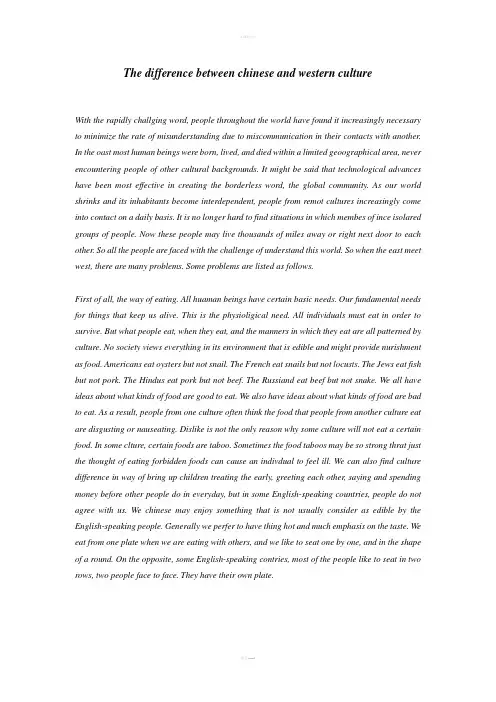
The difference between chinese and western cultureWith the rapidly challging word, people throughout the world have found it increasingly necessary to minimize the rate of misunderstanding due to miscommunication in their contacts with another. In the oast most human beings were born, lived, and died within a limited geoographical area, never encountering people of other cultural backgrounds. It might be said that technological advances have been most effective in creating the borderless word, the global community. As our world shrinks and its inhabitants become interdependent, people from remot cultures increasingly come into contact on a daily basis. It is no longer hard to find situations in which membes of ince isolared groups of people. Now these people may live thousands of miles away or right next door to each other. So all the people are faced with the challenge of understand this world. So when the east meet west, there are many problems. Some problems are listed as follows.First of all, the way of eating. All huaman beings have certain basic needs. Our fundamental needs for things that keep us alive. This is the physioligical need. All individuals must eat in order to survive. But what people eat, when they eat, and the manners in which they eat are all patterned by culture. No society views everything in its environment that is edible and might provide nurishment as food. Americans eat oysters but not snail. The French eat snails but not locusts. The Jews eat fish but not pork. The Hindus eat pork but not beef. The Russiand eat beef but not snake. We all have ideas about what kinds of food are good to eat. We also have ideas about what kinds of food are bad to eat. As a result, people from one culture often think the food that people from another culture eat are disgusting or nauseating. Dislike is not the only reason why some culture will not eat a certain food. In some clture, certain foods are taboo. Sometimes the food taboos may be so strong thrat just the thought of eating forbidden foods can cause an indivdual to feel ill. We can also find culture difference in way of bring up children treating the early, greeting each other, saying and spending money before other people do in everyday, but in some English-speaking countries, people do not agree with us. We chinese may enjoy something that is not usually consider as edible by the English-speaking people. Generally we perfer to have thing hot and much emphasis on the taste. We eat from one plate when we are eating with others, and we like to seat one by one, and in the shape of a round. On the opposite, some English-speaking contries, most of the people like to seat in two rows, two people face to face. They have their own plate.On the aspect of table manners, there are many differences between chinese and English-speaking people. For example, in some Englishi-speaking countries, Bread plates are to the left of the main plate, beverage glasses are to the right. Salad fork, knife and soup spoon are further from the main plate than the main course knife, fork and spoon. When eating bread rolls, break off a piece before buttering. Use the knife only to butter the bread, not to cut it. They should not start eating before your host does or instructs to do so. At larger meals, it is considered okay to start eating once others have been served. When finished, place the knife and fork together at five o’clock with the fork on the left. It is considered rude to answer the telephone at the table. If need to take an urgent call, excuse self and go outside. Try to eat all the food you are served. But in China, the table manners are different. Chinese traditionally eat rice from a small bowl held in the left hand. The rice bowl is raised to the mouth and the rice pushed into the mouth using the chopsticks. Some Chinese find it offensive to scoop rice from the bowl using a spoon. If rice is served on a plate, as is more common in the West, it is acceptable and more practical to eat it with a fork or spoon. The thumb must always be above the edge of the bowl. The host should always make sure the guests drinks are sufficiently full. One should not pour for ones self, but should offer to pour for a neighbor. When your drink is being poured, you should say "thank you" and tap fingers on the table to show appreciation. When people wish to clink drinks together in the form of a cheer, it is important to observe that younger members should clink the edge of their drink below the edge of an elder to show respect.Secondly, the way of communication. Form birth to death, communication plays an integral part in our life. There are some language problems, including the different styles of using language such as direct, indirect; expansive, succinct; argumentative, conciliatory; instrumental, harmonnizing; and so on. These different styles can lead to wrong interpretations of intent and evaluation of insincerity, aggreeiveness, deviousness, or arrogance, among other. The misinterpretation nonverbal signs and symbols such as gestures, postures, and other body movements. It is a definite communication barrier. But it is possible to learn the meanings of these observable message,usually in informal rather ways. It is more difficult to understand the less obvious unspoken codes of the other cultures.Language, as the carrier of cul ture, is created during the process of human beings’ productive labor and serves as the tool of communication to convey the message between people. However, it has been endowed with magic and power in particular language acts. As the old saying goes, troubles come out of the tongue. Superstitious people think that the language itself can bring about fortune or misfortune so that taboos to restrict the use of language are created. Anyone who violates them will get punishment, whereas those who faithfully obey the restrictions of language taboo will get protection. Furthermore, linguistic taboos change with the development of society .The paper firstly analyzes the evolution of linguistic taboo. It is indicated in the paper that linguistic taboo exists in almo st every aspect of people’s life and is a universal social phenomenon in China and Britain. Both Chinese and English cultures are in agreement about linguistic taboos such as pronunciation taboo, and vocabulary taboo. However, influenced by different cultural backgrounds, ideologies and the concepts of value, Chinese and English linguistic taboos also have differences, as is discussed in the paper from the aspects of taboo subjects, taboo numbers and names. At last, this paper puts forward two effective ways of avoiding taboo, that is, using euphemism and having a good knowledge of the taboo culture. And this discussion would help English learners improve their ability of cross-cultural communication and achieve better communicational effects. For example, During the feudal times, people were not equal to the rulers and were suppressed by their superiors. The distinction between the upper and the lower classes was also reflected in the evaluation of the language used by them respectively. The words of upper class used were considered good and elegant while those used by the lower class were regarded as vulgar and indecent and should be avoided in the speech of ladies and gentlemen. In modern society, as a result of the development of science and technology, many natural phenomena are no longer mysterious. Human beings not only constantly improve their abilities to exploit the world where they are living through their great wisdom and knowledge, but also make efforts to explore the extraterrestrial world. Science has much more say in today’s society. Thereby, the superstitious elements in linguistic taboos decrease while those reflecting spiritual civilization increase.In short, by comparison, we can find that both Chinese and English communication reflect peopl e’s psychology for good will, for safety and fortune and pleasantness. The Chinese and English people restrict their words and deeds through taboos, trying to keep a harmonious relationship between human and nature, or between people and society. They are a reflection of people’s pursuit of freedom and equality.The most important, the different way of family structure, family values and family education. Family structure is the big difference between east and west, traditional chinese, amony many other Asians, repect their elders and feel a deep sense of duty toward them. Children repay their parents` sacrifices by being successful and supporting them in old age. This is accepted as a natural part of life in China. In contrast, taking care of aged parents is often viewed as a tremendous burden in the English-speaking countries, where aging and family support are not honored highly. In some English-speaking countries are still extrmely family-oriented. They are dedicated to helping their children and will sacrifice greatly for their children to get an edcuation. In turn, the children are devoted to their parents, who often live nearby. Grown children who go away and leave the country for the economic reasons typically send large parts of their salary home to their parents and the rest of the family. Or in some Asia, any decisions or actions are done from family consideration, not individual desires. Peope`s behavior is judged on whether it brings shame or pride to the family. The children are trained to rely on their families, to honor elderly people, and to fear foreigners. And many of them think that their actions in this life will influence their status in the next life. The way of family edcation is also the different. We all know the family education is the elementary education for children. Many serious problems have appeared in our education system in recent years. Almost everyone has realized the importance of solving these problems and many people have presented a lot of valuable suggestions. There are many types of family education in the world and each of them shows distinctive features and is closely responsive to its culture. And American family education is the most famous one among them. There are great differences in the concepts of education, methods of education and results of education between East family education and West family education. In some English-speaking countries, parents’ aims are to train their children to have the ability of adapting to environmental variety and the ability of living independently. Based on this concept, most American parents emphasize more to train their children’s ability of independence once they are born. They generally believe that children’s growth must rely on their own experiences, because they think that children should form a self-supporting will and the capacity to live independently since their childhood. And the capacity comes from the training in the early age. The so-called training contains many aspects, such as work, temper will, patience, the spirit of hard work, etc. However, the most fundamental training is the ability of adapting to hard conditions. Through the process of work, children will form the labor sense, learn some work skills and form a habit of labor. Besides, children can learn how to overcome difficulties, temper their willpower, develop their talents and skills, rich their knowledge, and form a habit of hard work and thrifty by working in hard conditions. It is just in the unconsciously process that children will obtain the independent survivability and take the responsibilities for the society. Compared with someEnglish-speaking countries, Chinese parents have a very different concept of children’s education. Some parents inChina only care about whether the children have a promising future, a good job, a good life or not. Based on these expectations, the majority of parents feel that their responsibility for their children is to create as good conditions as possible they can so that the children will not worry about anything in the future. Chinese parents would like to provide everything what they can for their children in the process of children’s growth. In short, they would like to sacrifice anything if their children can live better with their help. Therefore, in the process o f children’s growth, the most important thing the parents concerning is to developing their children’s intellect, except for caring children’s daily life. In order to make their children have a good performance in study, become outstanding, or even become a famous person in the future, they would not let children do anything except studying. As for the children’s independence, civic awareness and their ability adapting to the society in the future, they consider little or not at all. From these aspects we can find the obvious differences of family education betweenAmerica and China.When we faced with those difference between West and East, we should give some advice to solve these problems. According to the three big difference that pointed, we should find some way to deal with these problems.We can study other languages and learn to expect in nonvwebal forms and other cultural aspects. We can train ourselves to meet intercultural encounters with more attention to situation details. We can use an investigative approach rather than stereotypes and preconceptions. We can gradually expose ourselves to differences so that they become less threatening. We can even learn to lower our tension level when needed to advoid triggering defensive reactions. The overall goal should be to achieve intercultural communication competence.So the ideal solution to reduce the problems are to share knowledge with others in communication. This is why it is easiest to communicate with other members of the same group. This is why people so often gather together socially with others who are very much like them. Since intercultural communication is communication with members of different cultual groups, and therefore, because we do not share knowledge, assumptions, values, and forms of discourse with them, we must expect there to be problems of interpretation. We must look for these problems, anticipate where they will arise out of our differences, and then plan our aommunications to be as effective as possible. However, we have to remember that, most of the time, the different ways that are the customs of dfferent cultures are neither right nor wrong. It is simply that different people do the same tings in different manners, even though we can not understand ,we should show the respect. I believe this is the best way to make our life become more comfortable and make the world more harmonious.. ..。
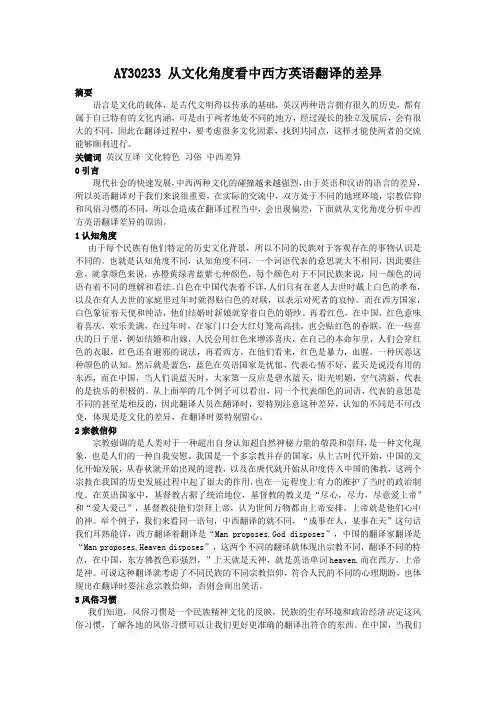
AY30233 从文化角度看中西方英语翻译的差异摘要语言是文化的载体,是古代文明得以传承的基础,英汉两种语言拥有很久的历史,都有属于自己特有的文化内涵,可是由于两者地处不同的地方,经过漫长的独立发展后,会有很大的不同,因此在翻译过程中,要考虑很多文化因素,找到共同点,这样才能使两者的交流能够顺利进行。
关键词英汉互译文化特色习俗中西差异0引言现代社会的快速发展,中西两种文化的碰撞越来越强烈,由于英语和汉语的语言的差异,所以英语翻译对于我们来说很重要,在实际的交流中,双方处于不同的地理环境,宗教信仰和风俗习惯的不同,所以会造成在翻译过程当中,会出现偏差,下面就从文化角度分析中西方英语翻译差异的原因。
1认知角度由于每个民族有他们特定的历史文化背景,所以不同的民族对于客观存在的事物认识是不同的。
也就是认知角度不同,认知角度不同,一个词语代表的意思就大不相同,因此要注意。
就拿颜色来说,赤橙黄绿青蓝紫七种颜色,每个颜色对于不同民族来说,同一颜色的词语有着不同的理解和看法。
白色在中国代表着不详,人们只有在老人去世时戴上白色的孝布,以及在有人去世的家庭里过年时就得贴白色的对联,以表示对死者的哀悼。
而在西方国家,白色象征着天使和纯洁,他们结婚时新娘就穿着白色的婚纱。
再看红色,在中国,红色意味着喜庆,欢乐美满,在过年时,在家门口会大红灯笼高高挂,也会贴红色的春联,在一些喜庆的日子里,例如结婚和出嫁,人民会用红色来增添喜庆,在自己的本命年里,人们会穿红色的衣服,红色还有避邪的说法,再看西方,在他们看来,红色是暴力,血腥,一种厌恶这种颜色的认知。
然后就是蓝色,蓝色在英语国家是忧郁,代表心情不好,蓝天是说没有用的东西,而在中国,当人们说蓝天时,大家第一反应是碧水蓝天,阳光明媚,空气清新,代表的是快乐的积极的。
从上面举的几个例子可以看出,同一个代表颜色的词语,代表的意思是不同的甚至是相反的,因此翻译人员在翻译时,要特别注意这种差异,认知的不同是不可改变,体现是是文化的差异,在翻译时要特别留心。
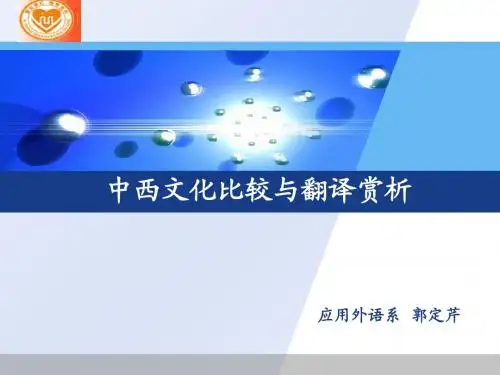
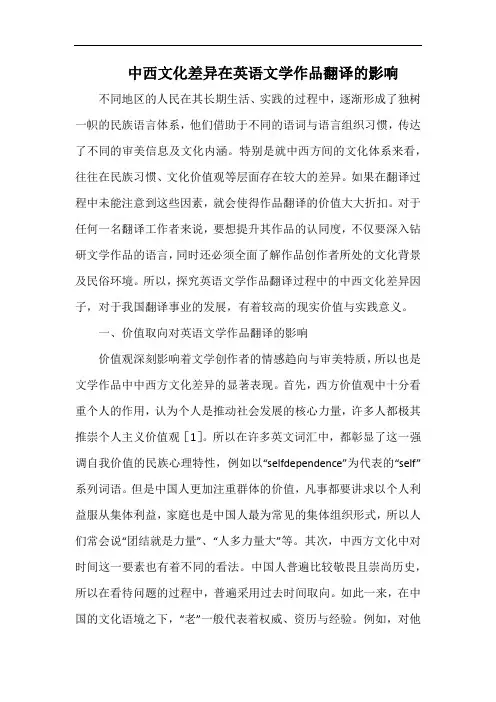
中西文化差异在英语文学作品翻译的影响不同地区的人民在其长期生活、实践的过程中,逐渐形成了独树一帜的民族语言体系,他们借助于不同的语词与语言组织习惯,传达了不同的审美信息及文化内涵。
特别是就中西方间的文化体系来看,往往在民族习惯、文化价值观等层面存在较大的差异。
如果在翻译过程中未能注意到这些因素,就会使得作品翻译的价值大大折扣。
对于任何一名翻译工作者来说,要想提升其作品的认同度,不仅要深入钻研文学作品的语言,同时还必须全面了解作品创作者所处的文化背景及民俗环境。
所以,探究英语文学作品翻译过程中的中西文化差异因子,对于我国翻译事业的发展,有着较高的现实价值与实践意义。
一、价值取向对英语文学作品翻译的影响价值观深刻影响着文学创作者的情感趋向与审美特质,所以也是文学作品中中西方文化差异的显著表现。
首先,西方价值观中十分看重个人的作用,认为个人是推动社会发展的核心力量,许多人都极其推崇个人主义价值观[1]。
所以在许多英文词汇中,都彰显了这一强调自我价值的民族心理特性,例如以“selfdependence”为代表的“self”系列词语。
但是中国人更加注重群体的价值,凡事都要讲求以个人利益服从集体利益,家庭也是中国人最为常见的集体组织形式,所以人们常会说“团结就是力量”、“人多力量大”等。
其次,中西方文化中对时间这一要素也有着不同的看法。
中国人普遍比较敬畏且崇尚历史,所以在看待问题的过程中,普遍采用过去时间取向。
如此一来,在中国的文化语境之下,“老”一般代表着权威、资历与经验。
例如,对他人表示尊敬时我们常说“老先生”、“老干部”,但在西方文化之中,代表“老”一词的英语“old”,却经常用于不屑和鄙夷的语气之中,展现了某一主体无竞争力的潜在危险。
所以当我们翻译“上了年纪”的时候,应当避免直接使用“old”一词,而是将其转化为“goldenage”、“ad-vancedage”等词,从而避免引起不必要的文化冲突。
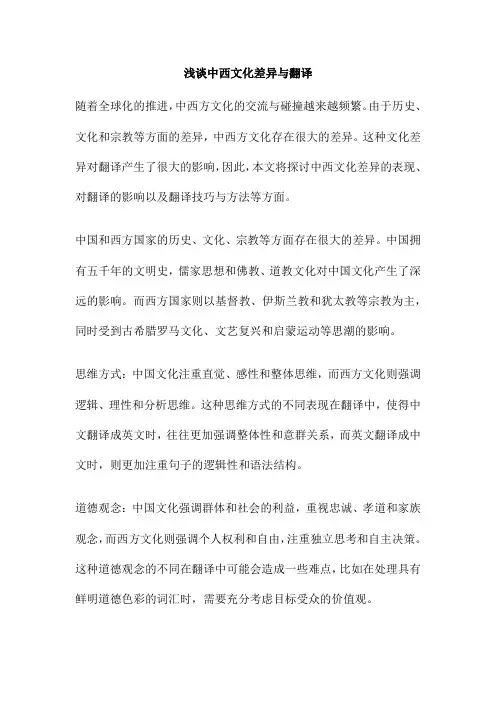
浅谈中西文化差异与翻译随着全球化的推进,中西方文化的交流与碰撞越来越频繁。
由于历史、文化和宗教等方面的差异,中西方文化存在很大的差异。
这种文化差异对翻译产生了很大的影响,因此,本文将探讨中西文化差异的表现、对翻译的影响以及翻译技巧与方法等方面。
中国和西方国家的历史、文化、宗教等方面存在很大的差异。
中国拥有五千年的文明史,儒家思想和佛教、道教文化对中国文化产生了深远的影响。
而西方国家则以基督教、伊斯兰教和犹太教等宗教为主,同时受到古希腊罗马文化、文艺复兴和启蒙运动等思潮的影响。
思维方式:中国文化注重直觉、感性和整体思维,而西方文化则强调逻辑、理性和分析思维。
这种思维方式的不同表现在翻译中,使得中文翻译成英文时,往往更加强调整体性和意群关系,而英文翻译成中文时,则更加注重句子的逻辑性和语法结构。
道德观念:中国文化强调群体和社会的利益,重视忠诚、孝道和家族观念,而西方文化则强调个人权利和自由,注重独立思考和自主决策。
这种道德观念的不同在翻译中可能会造成一些难点,比如在处理具有鲜明道德色彩的词汇时,需要充分考虑目标受众的价值观。
艺术风格:中国传统文化艺术风格独特,如国画、书法、剪纸等,而西方文化艺术则以写实和形式美为主。
这种艺术风格的不同使得中西方文学作品在表现形式和内涵上大相径庭,对翻译者来说,需要充分理解并尊重不同文化艺术风格,尽可能准确地传达原文的意境。
习俗习惯:中西方在生活习惯、节日庆典等方面也存在显著的差异。
例如,中国人过春节、清明节等传统节日时,讲究团圆和祭祖,而西方人则不过这些节日。
这些习俗习惯的不同在翻译中需要有所体现,并需要对目标受众的文化背景和习俗有所了解,以避免产生误解或冒犯。
文化差异对翻译的影响是显而易见的。
在翻译策略上,为了尽可能减少文化冲突和误解,翻译者需要采用一些技巧和方法,如增译、减译、改写等,以适应目标受众的文化背景和语言习惯。
在翻译方法上,直译和意译是两种最基本的翻译方法。



浅析中西方文化差异与英语翻译论文无论是在学习还是在工作中,大家都经常接触到论文吧,通过论文写作可以培养我们独立思考和创新的能力。
相信很多朋友都对写论文感到非常苦恼吧,下面是店铺精心整理的浅析中西方文化差异与英语翻译论文,欢迎大家借鉴与参考,希望对大家有所帮助!浅析中西方文化差异与英语翻译论文篇1摘要:翻译的本质是两种文化的交流。
文化的差异是一个译者必须要处理好的问题,如果处理不当就容易让读者产生歧义。
分析了中西方主要的文化差异,并对主要的差异进行了举例说明。
介绍了对于这种差异的基本翻译方法,它们分别是:异化法、归化法和音译法。
并对这些方法进行了解释。
关键词:文化差异;处理方法;异化法;归化法;音译法1、语言是社会的产物,是人类历史和文化的结晶它凝聚着一个民族世代相传的社会意识,历史文化,风俗习惯等各方面人类社会所有的特征。
不同的文化需要沟通。
沟通离不开翻译,可见文化及其交流是翻译发生的本源,翻译是文化交流的产物。
翻译教学和研究的经验表明:翻译理论和技巧必须建立在不同语言和文化的对比分析的基础上。
翻译之所以困难,归根结底是语言差异和文化差异。
英汉两种语言在表达方式上有相似之处,但2012年02月13日09时09分,《英语学习:英语论文:简析中西方文化差异与英语翻译[1]》由出国英语编辑整理。
2、译法汉语文化中特有的事物在英语文化中完全空缺,这时可采用音译法将具有特殊文化内涵的词语“移植”到英语文化中去。
如:“功夫”kong fu、“乌龙茶”oolong等。
许多采用音译法翻译的词语已成为英语中的外来词,被西方大众广泛接受。
3、结语语言是文化的一部分,也是文化的传承者。
文化依靠语言进行传播、交流。
东西方文化的差异对英汉互译产生了深远的影响。
因此对于译者来说熟悉中英两种文化甚至比掌握这两种语言更为重要。
翻译离不开文化,没有基于文化的翻译是达不到交流的目的的。
本文只列举了三种基本的翻译方法,对于文化意象处理的问题,并没有统一的翻译方法和公式,译者应根据上下文灵活处理。
英语文学翻译探讨中西文化的差异一、文学翻译中中西文化差异的具体表现(一)生活习惯差异除了历史传统文化的差异外,中西文化的差异还体现在生活、风俗习惯的差异上。
5中西方文化生活习惯方面的差异,是比较明显的。
诸如中国人见到熟人,会习惯说:“去哪儿了?”“吃过了吗?”等类似的语句,但是传递出来的意思并不是真正要问对方打算去什么地方或是有没有吃饭,而是没有实际意义的问候语。
不过在英语文学翻译作品里可以看到,礼貌用语都是一些具有实际意义和真实性的语句,很少涉及到一些形式问候语。
在英语文学翻译中,经常会遇到情景对话的环节,在这些情景对话中,可以清楚地看到,西方文化中的问候习惯与我国有明显的差异,作品中的人物如果要进行问候,便是直白简单切合当时情景的表达。
除问候习惯的不同之外,中西方礼貌习惯方面也存有较大的差异。
我国礼貌习惯的最大特征在于“卑己尊人”6,包括孝道等,都是通过晚辈对长辈的谦恭来体现“礼貌”这一行为,并且将这种“谦让、谦卑”的文化当成一种崇高的美德。
当别人对我们发出赞叹或是表扬的语句或语气时,我们通常会进行自贬以示礼貌,这一礼貌习俗是中国的一大特殊文化现象。
而西方的礼貌习惯与中国恰恰相反。
一般情况下,一方对另一方进行夸赞,并且是符合对方实际情况的,受夸赞的一方通常都会接受这一赞美或是赞叹,并对赞扬者说“谢谢你”,以此表示对对方肯定的感谢。
因为中西文化存有的巨大差异,我们往往会认为西方人比较自信且不谦虚。
而作为西方人来说,对于中国人对自己成就的贬低,也表示不理解,觉得中国人不太诚实或是诚恳。
7因此,对于中西方在文化生活习惯上存有的差异,需要进行更为深刻的探讨和挖掘。
(二)思维方式的差异思维方式的差异,从本质上来说,是基于语言而逐步产生和形成的一种较为深层的特有机制,并且其具体表现是在语言形式之中。
从英语文学翻译作品来看,思维方式也是中西方文化差异的表现之一。
思维方式的差异是进一步造成文化差异的一个重要原因,同时,也是导致语言差异的重要诱因。
长春教育学院学报2008年第4期战问题。
当美国得知苏联军队对东北卫矿企业采取的举措,以及向中国提出经济合作的要求,均已越出了雅尔塔协定的范围,便于1946年2月9日、11日分别照会中苏两国政府,申明“中苏两国如就此事成立协定,则显系对美国故示歧视”。
由于苏联未作答复,3月5日,美国再次照会苏联政府,指出“如苏联及中国政府,将来订立协定,带有独占性质,不予别国以参加机会,则美国政府即将认为与门户开放原则相抵触,不能承认”。
国民党政府显然与美国有着密切的关系,苏联看出蒋介石与美国完全沆瀣一气,这使苏联担心美国的势力会随国民党军队进入东北,担心自已在东北的权益受到削弱。
同时,苏联做出的种种改善与国民党关系的努力,并没有得到国民党的响应,苏、蒋关系再度紧张。
苏联对国共两党的态度再次发生变化:为进入东北的国民党军队设置障碍,延缓甚至阻挡其军事行动的进行;对共产党则予以支持,以实现共产党争夺东北的方针。
继而又改变态度,支持我军于1月13日进攻鞍山,切断锦西电源,于1月14目击袭营口,攻占盘山,并由苏军出面于1月16日解除长春附近国民党新编之保安队1000人。
整体上看,苏联在出兵东北期问,《雅尔塔协定》及《中苏友好同盟条约》对其所规定的义务与苏联本身想获得大于两条约所规定的利益相冲突,为了扼制美国势力将来向东北的渗透,苏联对国共两党的态度不断地调整,这一切完全是从属于其大国利益的。
参考文献:[1]w格里斯沃德.美国的远东政策[M].纽约版,938.129.[2]中美关系资料汇编[M].新泽西版,1955.332.[3]梁敬缚.1945年中苏同盟条约谈判内幕[J].军事史林,1988,(4).[4]张宗海.苏联出兵东北[M].哈尔滨.黑龙江人民出版社,1998.31.[5]比米斯.美国国务卿及其外交(第10卷)[M].纽约版,1958.327.[6]常城,崔丕.世界列强与东北[M].北京.中国大百科全书出版社,98.[7]维维尔.美国与中国[M].新泽西版,1955.59.[8][9]-ZE芸生.六十年来之中国与日本(第七卷)[M].上海.三联书店,1987.35—36.[10]蒋经国.对苏交涉纪事节略[A].民国重要史料初编第七编(一)[C].113.[责任编辑:贺春健]中西文化差异与翻译李小园(中共浙江省衢州市委党校,浙江衢州324000)摘要:语言反映一个民族的文化,同时又受到文化的巨大影响,根植于不同文化背最下的英汉两种语言不可避免地存在着巨大的文化差异,本文分别从地域、宗教、习俗等多方面探讨中西文化差异与翻译。